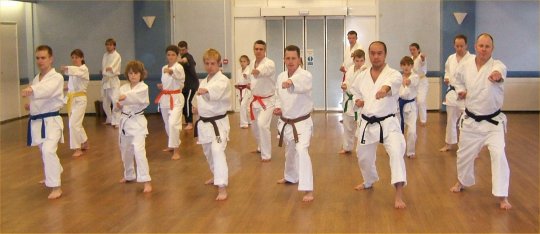The lesson begins very formally with everyone following a sequence of bows. This is done out of respect between students and instructors and is a mutual thing. It is done as a precursor to taking a serious attitude to the training at hand and to wish all best endeavours in the training ahead. Although many aspects of the training are done alone, for those that require working with a partner it is vitally important that both parties work to their best level in order that they may both benefit from the training.
Once the class has completed the bows, some time is spent on warming up the body and stretching. The aim is to reduce the likelihood of injuries and to prepare the body for the training ahead. The process of stretching is very beneficial to the body regardless of whether you are doing karate or not. We undertake this to increase our range of movements which in turn gives us greater control of our bodies and more possibilities for techniques and using our bodies.
After the warm up and stretching we move onto performing some basic techniques.
The three Ks of karate
In general life we may talk about the three Rs (for reading, writing and arithmetic) but in karate we talk about the 3 Ks which stand for Japanese terms of Kihon, Kata and Kumite. This is just a very simplistic view but I will use it here just to help give an overview of a typical karate lesson.
KIHON
Kihon (pronounced kee-hon) is generally translated as basics. I would caution against the use of the word basics as fundamentals is probably a much better word to use. These are the fundamental movements and techniques that are used throughout karate. You never move away from them.
At times trying to use English language translations can in fact take away many of the nuances and meanings behind the Japanese words. Better to grasp the concepts as best and as wide as you can.
For the sake of a readable web site I will however use appropriate translations as I see fit but suggest that you seek out the answers through training.
Using the word basic implies that there is something advanced. I would argue that using the word fundamentals, if we were to use a translation, is a better approach as the fundamentals learnt must be applied to and permeate everything you do in Wado Ryu karate.
Kihon will involve performing a variety of punches, strikes, blocks and kicks in layman's terms. These could be done on the spot and then done in a moving fashion. These may then been strung together in a sequence that challenges your body and limb control along with applying different methods of movement at the same time.

This photo is actually taken from the nearby Farnham club, with the students performing the technique called junzuki.
KATA
Kata (pronounced ka-ta) could be described as a fixed sequence of predefined karate movements. It could be described poetically as a dance and some may describe it as an imaginary battle against many opponents.
I will let the movie below speak for itself in showing you a Wado Ryu kata called Seishan.
Hopefully that conveys what kata is without me typing too many words. What I will say before I move on, is that kata should be done with a physical and mental intent that brings it alive. Completing the shapes and movement without those two aspects means that the kata is dead.
KUMITE
The final K refers to kumite (pronounced koo-mee-te). I prefer to say that kumite represents two people engaging in combat with one another. A translation that other might use is sparring but that reduces the practice to a meaningless sporting level. Even though many of the kumite routines that we practice in Wado Ryu are prearranged and ultimately controlled for safety to each other, they must still be performed with an intent to defeat your opponent.
In Wado Ryu we train to adopt an approach to kumite that is always based on a strategy of attack. It is not self defence. Even though the pairwork might look from the outside that there is someone attacking and the other person defending, the mental attitude must always be of attack.
The class always ends with a closing bow identical to the start of the class.